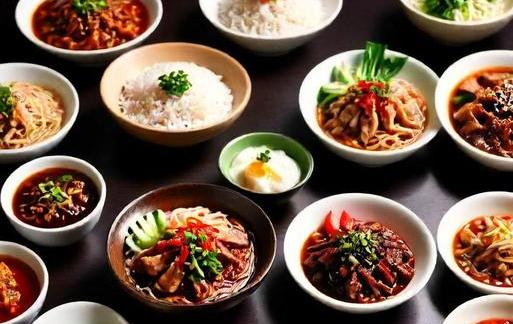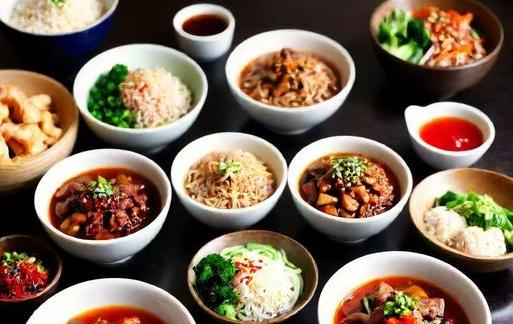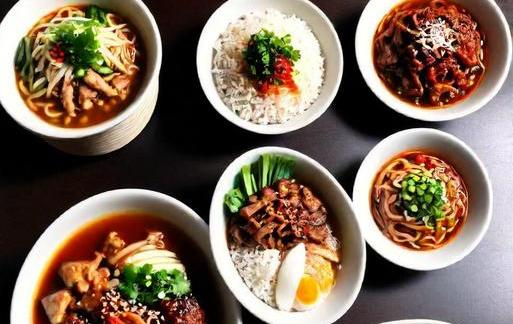- You are here:
- Home »
- Food
- » [REVEALED] Asian Foods That Start With P
[REVEALED] Asian Foods That Start With P
Note: This page contains affiliate links.
As an Amazon Associate, I earn from qualifying purchases when you click on the link, but you are not charged extra.
Asian cuisine is a rich tapestry of flavors, textures, and aromas, with each region boasting a unique culinary identity. From the bustling street markets of Bangkok to the serene tea gardens of Japan, Asian foods captivate the senses and showcase the diversity of ingredients and cooking techniques. In this gastronomic journey, we explore the realm of Asian foods that start with the letter “P”. Prepare to embark on a culinary adventure that traverses the landscapes of palate-pleasing delights.
Contents
List Of Asian Foods That Start With P

1. Pho (Vietnam)
Description:
Pho, a Vietnamese noodle soup, is a culinary masterpiece that has gained international acclaim. It features flat rice noodles, thinly sliced beef or chicken, and a fragrant broth infused with spices like star anise, cinnamon, and cloves. Garnished with fresh herbs, bean sprouts, and lime, pho is a harmonious blend of savory, sweet, and aromatic flavors.
Preparation:
The preparation of pho involves simmering bones, spices, and charred onions to create a rich broth. The noodles are then cooked separately, and the dish is assembled by placing the noodles in a bowl, adding the meat, and pouring the hot broth over the top. The final touch includes a garnish of cilantro, basil, lime, and bean sprouts.
2. Pad Thai (Thailand)
Description:
Pad Thai is a quintessential Thai street food dish that has become a global favorite. This stir-fried noodle dish features rice noodles, tofu or shrimp, bean sprouts, peanuts, and lime. The key to its irresistible taste lies in the perfect balance of sweet, sour, salty, and spicy flavors.
Preparation:
To prepare Pad Thai, rice noodles are soaked and then stir-fried with a combination of ingredients like tofu or shrimp, tamarind paste, fish sauce, and chili. The dish is topped with crushed peanuts and garnished with lime and cilantro. It’s a delightful symphony of textures and tastes.
3. Peking Duck (China)
Description:
Peking Duck, a culinary gem from China, is a dish that embodies sophistication and culinary finesse. The dish features thin, crispy slices of duck skin and meat, served with hoisin sauce, thin pancakes, and sliced scallions. The skin is prized for its crispy texture, while the meat remains succulent and flavorful.
Preparation:
The preparation of Peking Duck is a meticulous process that involves air-drying the duck, seasoning it with a blend of spices, and roasting it until the skin achieves a crispy perfection. The duck is then carved into thin slices and served with accompaniments. Peking Duck is often associated with special occasions and festive celebrations in Chinese culture.
4. Phaal Curry (India)
Description:
Phaal Curry is a fiery and robust curry originating from Indian cuisine. Known for its intense heat and complex spice blend, this dish is not for the faint of heart. It typically features a variety of chili peppers, spices, and a base of meat, making it a flavorful yet challenging experience for spice enthusiasts.
Preparation:
The preparation of Phaal Curry involves a medley of spices, including cumin, coriander, and turmeric, along with a potent mix of chili peppers. Meats such as chicken, lamb, or beef are slow-cooked in this spicy concoction until they absorb the rich flavors. Phaal Curry is a testament to the diverse and bold flavors found in Indian cuisine.
5. Pulut Inti (Malaysia)
Description:
Pulut Inti is a traditional Malaysian dessert that combines the sweetness of coconut and palm sugar with the stickiness of glutinous rice. It is often served during festive occasions and celebrations, making it a beloved treat across the country.
Preparation:
The preparation involves cooking glutinous rice until it achieves a sticky consistency. The rice is then mixed with coconut milk and palm sugar, creating a luscious filling. The mixture is wrapped in banana leaves, giving Pulut Inti its distinctive appearance. The result is a delightful blend of textures and flavors, with the sweetness of the coconut and palm sugar complementing the sticky rice.
6. Pajeon (South Korea)
Description:
Pajeon, a popular Korean pancake, is a savory delight that showcases the versatility of Asian cuisine. Loaded with scallions and sometimes seafood or kimchi, Pajeon is a crispy and flavorful pancake often enjoyed as a snack or appetizer.
Preparation:
The preparation involves creating a batter with a mixture of flour, water, and egg, which is then combined with chopped scallions and additional ingredients like seafood or kimchi. The batter is pan-fried until golden and crispy, resulting in a savory pancake with a satisfying crunch. Pajeon is often served with a dipping sauce made from soy sauce, vinegar, and sesame oil.
7. Palak Paneer (India)
Description:
Palak Paneer is a popular vegetarian dish from North India that features cubes of paneer (Indian cottage cheese) in a rich and creamy spinach sauce. This dish not only delights the taste buds but also provides a nutritious combination of greens and protein.
Preparation:
To prepare Palak Paneer, fresh spinach is blanched and pureed, creating a vibrant green base for the curry. The paneer is lightly fried and then simmered in the spinach sauce, along with a blend of aromatic spices like cumin, coriander, and garam masala. The result is a wholesome and flavorful dish that pairs well with Indian bread or rice.
8. Pad See Ew (Thailand)
Description:
Pad See Ew, a Thai stir-fried noodle dish, is celebrated for its comforting and slightly sweet flavor profile. Flat rice noodles are stir-fried with soy sauce, Chinese broccoli, and a choice of meat, creating a satisfying and wholesome meal.
Preparation:
The preparation of Pad See Ew involves stir-frying flat rice noodles with a combination of dark soy sauce, light soy sauce, and oyster sauce. Chinese broccoli, meat (commonly chicken or beef), and egg are added to the wok, creating a harmonious blend of textures and flavors. The dish is then seasoned with a dash of vinegar or lime juice for a perfect balance.
9. Poh Piah (Singapore)
Description:
Poh Piah, also known as popiah, is a fresh spring roll originating from Singapore. Filled with a medley of ingredients like jicama, bean sprouts, and prawns, Poh Piah is a light and refreshing snack that reflects the vibrant culinary landscape of Singapore.
Preparation:
The preparation involves making a thin and pliable wrapper from a mixture of wheat flour, water, and cornstarch. The filling, a combination of jicama, bean sprouts, prawns, and other ingredients, is then placed on the wrapper and rolled into a delicate spring roll. Poh Piah is often served with a sweet and savory dipping sauce, adding an extra layer of flavor to this delightful snack.
10. Panta Bhat (Bangladesh)
Description:
Panta Bhat is a traditional Bengali dish from Bangladesh, especially enjoyed during the Bengali New Year celebrations. It consists of fermented rice soaked in water and is typically served with various accompaniments. This dish not only satiates hunger but also carries cultural significance.
Preparation:
The preparation of Panta Bhat involves soaking leftover rice in water for an extended period until it ferments. The fermented rice is then served with accompaniments like pickles, green chilies, fried fish, and various traditional Bengali side dishes. Panta Bhat represents the celebration of the harvest season and the renewal of life.
The journey through the diverse and delectable world of Asian foods that start with the letter 'P' reveals the rich tapestry of culinary traditions across the continent. From the comforting bowls of Pho in Vietnam to the fiery allure of Phaal Curry in India, each dish reflects the unique flavors, techniques, and cultural influences that make Asian cuisine a global sensation. Whether you find yourself savoring the crispy layers of Peking Duck in China or indulging in the sweet and sticky Pulut Inti of Malaysia, the culinary offerings are as varied as the landscapes that inspire them. Asian cuisine continues to captivate and inspire food enthusiasts worldwide, inviting them to explore the intricacies of flavors, textures, and aromas that define each dish. As we conclude this culinary journey, it's evident that the foods starting with 'P' in Asian cuisine are not just letters on a menu but gateways to cultural stories, festive celebrations, and moments of shared joy around the dining table. So, the next time you embark on a culinary adventure, consider exploring the world of Asian foods that start with 'P' and savor the delicious tales they have to tell.
Significance

Asian cuisine is a rich tapestry of flavors, textures, and aromas that have captivated food enthusiasts around the globe.
The significance of exploring Asian foods that start with the letter P lies in the opportunity to delve into the culinary heritage of a vast and diverse continent. Asia, with its numerous countries and cultures, boasts an extensive variety of ingredients, cooking techniques, and unique flavor profiles. This article sheds light on the lesser-known but equally tantalizing dishes that begin with the letter P, providing a deeper understanding of the rich gastronomic landscape of Asia.
Category-Related

1. Peking Duck (China)
Originating from China, Peking Duck is a celebrated dish with a history dating back to the imperial era. The dish involves roasting a whole duck until the skin is crispy and golden, then serving it with thin pancakes, hoisin sauce, and sliced scallions. The crispy skin contrasts with the succulent meat, creating a harmonious blend of textures and flavors.
2. Pho (Vietnam)
Pho, a Vietnamese noodle soup, has gained international acclaim for its aromatic broth and delicate rice noodles. Typically made with beef or chicken, Pho is flavored with a combination of spices such as star anise, cinnamon, and cloves. Garnished with fresh herbs, bean sprouts, and lime, this dish embodies the essence of Vietnamese cuisine.
3. Pad Thai (Thailand)
Hailing from the vibrant street markets of Thailand, Pad Thai is a stir-fried noodle dish that has become a global favorite. Combining rice noodles with tofu, shrimp, or chicken, Pad Thai is seasoned with tamarind paste, fish sauce, and chili, creating a perfect balance of sweet, salty, and spicy flavors.
4. Palak Paneer (India)
In the realm of Indian cuisine, Palak Paneer stands out as a vegetarian delight. This dish features cubes of paneer (Indian cheese) cooked in a creamy spinach gravy. Fragrant with spices such as cumin, coriander, and garam masala, Palak Paneer is a flavorful and nutritious option in the diverse landscape of Indian curries.
5. Pulut Inti (Malaysia)
Pulut Inti is a traditional Malaysian dessert that showcases the culinary prowess of the country. Comprising sticky glutinous rice topped with sweetened coconut and palm sugar, this sweet treat is often wrapped in banana leaves. The contrasting textures and subtle sweetness make Pulut Inti a beloved indulgence in Malaysian culinary traditions.
Common Themes
Despite the geographical and cultural diversity across Asia, certain common themes emerge in the culinary landscape of Asian foods that start with P. These themes contribute to the richness and depth of flavors, creating a harmonious balance that characterizes many Asian dishes.
1. Rice As A Staple
One prevalent theme is the central role of rice in many Asian cuisines. From Pad Thai in Thailand to Pulut Inti in Malaysia, rice serves as a staple ingredient, providing a versatile base for a variety of dishes. Whether steamed, stir-fried, or used in noodle form, rice is a unifying element that connects diverse Asian culinary traditions.
2. Bold And Balanced Flavors
Asian cuisine is renowned for its ability to balance a myriad of flavors – sweet, salty, sour, and spicy – in a single dish. This balance is evident in Peking Duck’s combination of crispy skin and succulent meat, the complex spice blend of Pho, and the sweet and savory profile of Pad Thai. The harmonious interplay of flavors is a defining characteristic that transcends borders and defines the essence of Asian gastronomy.
3. Herbs And Spices
Herbs and spices play a crucial role in Asian culinary traditions, enhancing the aroma and flavor of dishes. Whether it’s the aromatic blend of spices in Indian Palak Paneer or the fragrant herbs garnishing Vietnamese Pho, herbs and spices contribute depth and complexity to Asian foods. This common theme highlights the meticulous attention to seasoning that is intrinsic to Asian cooking.
Interesting Facts
Delving into the realm of Asian foods that start with P unveils a trove of interesting facts that add depth to the culinary exploration.
1. Peking Duck’s Elaborate Preparation
Peking Duck’s preparation is a meticulous process that involves inflating the duck with air to separate the skin from the meat, resulting in an incredibly crispy skin. The duck is then glazed with a syrupy mixture before being air-dried, creating a unique texture that has made this dish a culinary masterpiece.
2. Pho’s Global Influence
Pho, once a Vietnamese street food staple, has transcended its origins to become a global phenomenon. Its popularity has led to variations worldwide, with diverse interpretations in different countries. This widespread acclaim reflects the universal appeal of well-crafted, flavorful noodle soups.
3. Pad Thai’s Historical Roots
Pad Thai’s history is intertwined with Thailand’s efforts to promote a national identity. Created during World War II, the government sought to popularize Pad Thai as a symbol of Thai culture. Today, it stands as an iconic representation of Thai cuisine on the international stage.
4. Palak Paneer’s Nutritional Benefits
Beyond its flavorful profile, Palak Paneer offers significant nutritional benefits. Spinach, the main ingredient in the dish, is rich in vitamins, minerals, and antioxidants. Paired with protein-packed paneer, Palak Paneer provides a wholesome and nourishing dining experience.
5. Pulut Inti’s Cultural Significance
Pulut Inti holds cultural significance in Malaysia, often associated with celebrations and festivals. The meticulous preparation and presentation of this dessert showcase the country’s dedication to preserving and celebrating its culinary heritage. The use of banana leaves for wrapping adds an eco-friendly touch to this traditional sweet treat.
Conclusion
In conclusion, the exploration of Asian foods that start with P unveils a diverse and flavorful journey through the continent’s culinary landscape. From the iconic Peking Duck of China to the sweet indulgence of Malaysia’s Pulut Inti, each dish tells a unique story of cultural heritage, culinary innovation, and the universal love for exquisite flavors. As we savor these Asian delights, we not only indulge in delightful gastronomic experiences but also gain a deeper appreciation for the rich tapestry of traditions that make up the vibrant mosaic of Asian cuisine. So, whether you’re a seasoned food enthusiast or a curious newcomer, let the exploration of Asian foods that start with P be a gateway to the diverse and delicious world of Asian gastronomy.


